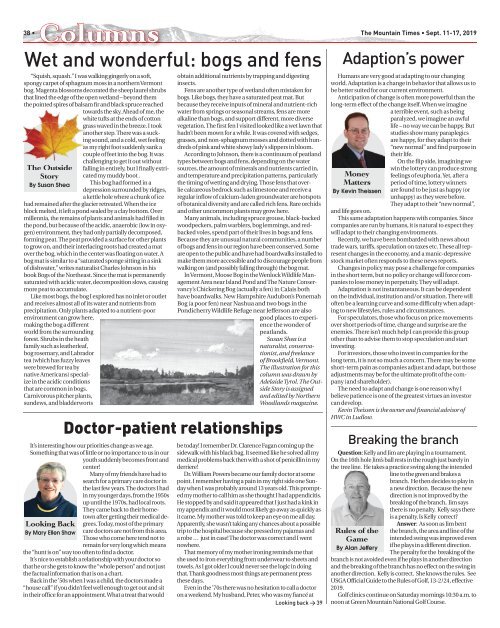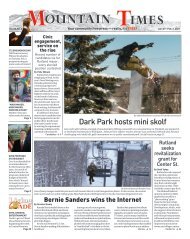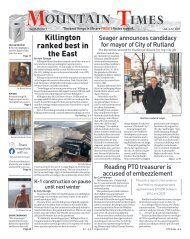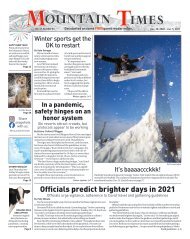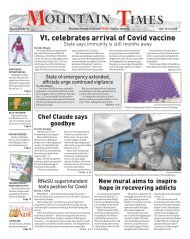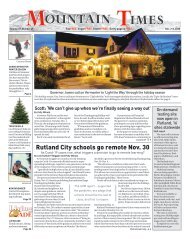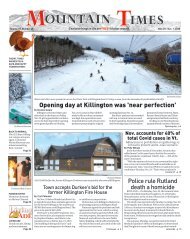The Mountain Times - Volume 48, Number 37: Sept. 11-17, 2019
Create successful ePaper yourself
Turn your PDF publications into a flip-book with our unique Google optimized e-Paper software.
Columns<br />
38 • <strong>The</strong> <strong>Mountain</strong> <strong>Times</strong> • <strong>Sept</strong>. <strong>11</strong>-<strong>17</strong>, <strong>2019</strong><br />
Wet and wonderful: bogs and fens<br />
“Squish, squash.” I was walking gingerly on a soft,<br />
spongy carpet of sphagnum moss in a northern Vermont<br />
bog. Magenta blossoms decorated the sheep laurel shrubs<br />
that lined the edge of the open wetland – beyond them<br />
the pointed spires of balsam fir and black spruce reached<br />
towards the sky. Ahead of me, the<br />
white tufts at the ends of cotton<br />
grass waved in the breeze. I took<br />
another step. <strong>The</strong>re was a sucking<br />
sound, and a cold, wet feeling<br />
as my right foot suddenly sank a<br />
couple of feet into the bog. It was<br />
<strong>The</strong> Outside<br />
Story<br />
By Susan Shea<br />
Looking Back<br />
By Mary Ellen Shaw<br />
challenging to get it out without<br />
falling in entirely, but I finally extricated<br />
my muddy boot .<br />
This bog had formed in a<br />
depression surrounded by ridges,<br />
a kettle hole where a chunk of ice<br />
had remained after the glacier retreated. When the ice<br />
block melted, it left a pond sealed by a clay bottom. Over<br />
millennia, the remains of plants and animals had filled in<br />
the pond, but because of the acidic, anaerobic (low in oxygen)<br />
environment, they had only partially decomposed,<br />
forming peat. <strong>The</strong> peat provided a surface for other plants<br />
to grow on, and their interlacing roots had created a mat<br />
over the bog, which in the center was floating on water. A<br />
bog mat is similar to a “saturated sponge sitting in a sink<br />
of dishwater,” writes naturalist Charles Johnson in his<br />
book Bogs of the Northeast. Since the mat is permanently<br />
saturated with acidic water, decomposition slows, causing<br />
more peat to accumulate.<br />
Like most bogs, the bog I explored has no inlet or outlet<br />
and receives almost all of its water and nutrients from<br />
precipitation. Only plants adapted to a nutrient-poor<br />
environment can grow here,<br />
making the bog a different<br />
world from the surrounding<br />
forest. Shrubs in the heath<br />
family such as leatherleaf,<br />
bog rosemary, and Labrador<br />
tea (which has fuzzy leaves<br />
were brewed for tea by<br />
native Americans) specialize<br />
in the acidic conditions<br />
that are common in bogs.<br />
Carnivorous pitcher plants,<br />
sundews, and bladderworts<br />
It’s interesting how our priorities change as we age.<br />
Something that was of little or no importance to us in our<br />
youth suddenly becomes front and<br />
center!<br />
Many of my friends have had to<br />
search for a primary care doctor in<br />
the last few years. <strong>The</strong> doctors I had<br />
in my younger days, from the 1950s<br />
up until the 1970s, had local roots.<br />
<strong>The</strong>y came back to their hometown<br />
after getting their medical degrees.<br />
Today, most of the primary<br />
care doctors are not from this area.<br />
Those who come here tend not to<br />
remain for very long which means<br />
the “hunt is on” way too often to find a doctor.<br />
It’s nice to establish a relationship with your doctor so<br />
that he or she gets to know the “whole person” and not just<br />
the factual information that is on a chart.<br />
Back in the ’50s when I was a child, the doctors made a<br />
“house call” if you didn’t feel well enough to get out and sit<br />
in their office for an appointment. What a treat that would<br />
obtain additional nutrients by trapping and digesting<br />
insects.<br />
Fens are another type of wetland often mistaken for<br />
bogs. Like bogs, they have a saturated peat mat. But<br />
because they receive inputs of mineral and nutrient-rich<br />
water from springs or seasonal streams, fens are more<br />
alkaline than bogs, and support different, more diverse<br />
vegetation. <strong>The</strong> first fen I visited looked like a wet lawn that<br />
hadn’t been mown for a while. It was covered with sedges,<br />
grasses, and non-sphagnum mosses and dotted with hundreds<br />
of pink and white showy lady’s slippers in bloom.<br />
According to Johnson, there is a continuum of peatland<br />
types between bogs and fens, depending on the water<br />
sources, the amount of minerals and nutrients carried in,<br />
and temperature and precipitation patterns, particularly<br />
the timing of wetting and drying. Those fens that overlie<br />
calcareous bedrock such as limestone and receive a<br />
regular inflow of calcium-laden groundwater are hotspots<br />
of botanical diversity and are called rich fens. Rare orchids<br />
and other uncommon plants may grow here.<br />
Many animals, including spruce grouse, black-backed<br />
woodpeckers, palm warblers, bog lemmings, and redbacked<br />
voles, spend part of their lives in bogs and fens.<br />
Because they are unusual natural communities, a number<br />
of bogs and fens in our region have been conserved. Some<br />
are open to the public and have had boardwalks installed to<br />
make them more accessible and to discourage people from<br />
walking on (and possibly falling through) the bog mat.<br />
In Vermont, Moose Bog in the Wenlock Wildlife Management<br />
Area near Island Pond and <strong>The</strong> Nature Conservancy’s<br />
Chickering Bog (actually a fen) in Calais both<br />
have boardwalks. New Hampshire Audubon’s Ponemah<br />
Bog (a poor fen) near Nashua and two bogs in the<br />
Pondicherry Wildlife Refuge near Jefferson are also<br />
good places to experience<br />
the wonder of<br />
peatlands.<br />
Susan Shea is a<br />
naturalist, conservationist,<br />
and freelance<br />
of Brookfield, Vermont.<br />
<strong>The</strong> illustration for this<br />
column was drawn by<br />
Adelaide Tyrol. <strong>The</strong> Outside<br />
Story is assigned<br />
and edited by Northern<br />
Woodlands magazine.<br />
Doctor-patient relationships<br />
be today! I remember Dr. Clarence Fagan coming up the<br />
sidewalk with his black bag. It seemed like he solved all my<br />
medical problems back then with a shot of penicillin in my<br />
derriere!<br />
Dr. William Powers became our family doctor at some<br />
point. I remember having a pain in my right side one Sunday<br />
when I was probably around 13 years old. This prompted<br />
my mother to call him as she thought I had appendicitis.<br />
He stopped by and said it appeared that I just had a kink in<br />
my appendix and it would most likely go away as quickly as<br />
it came. My mother was told to keep an eye on me all day.<br />
Apparently, she wasn’t taking any chances about a possible<br />
trip to the hospital because she pressed my pajamas and<br />
a robe … just in case! <strong>The</strong> doctor was correct and I went<br />
nowhere.<br />
That memory of my mother ironing reminds me that<br />
she used to iron everything from underwear to sheets and<br />
towels. As I got older I could never see the logic in doing<br />
that. Thank goodness most things are permanent press<br />
these days.<br />
Even in the ’70s there was no hesitation to call a doctor<br />
on a weekend. My husband, Peter, who was my fiancé at<br />
Looking back > 39<br />
Adaption’s power<br />
Humans are very good at adapting to our changing<br />
world. Adaptation is a change in behavior that allows us to<br />
be better suited for our current environment.<br />
Anticipation of change is often more powerful than the<br />
long-term effect of the change itself. When we imagine<br />
a terrible event, such as being<br />
paralyzed, we imagine an awful<br />
life – no way we can be happy. But<br />
studies show many paraplegics<br />
are happy, for they adapt to their<br />
“new normal” and find purpose in<br />
their life.<br />
On the flip side, imagining we<br />
Money<br />
Matters<br />
By Kevin <strong>The</strong>issen<br />
win the lottery can produce strong<br />
feelings of euphoria. Yet, after a<br />
period of time, lottery winners<br />
are found to be just as happy (or<br />
unhappy) as they were before.<br />
<strong>The</strong>y adapt to their “new normal”,<br />
and life goes on.<br />
This same adaptation happens with companies. Since<br />
companies are run by humans, it is natural to expect they<br />
will adapt to their changing environments.<br />
Recently, we have been bombarded with news about<br />
trade wars, tariffs, speculation on taxes etc. <strong>The</strong>se all represent<br />
changes in the economy, and a manic-depressive<br />
stock market often responds to these news reports.<br />
Changes in policy may pose a challenge for companies<br />
in the short term, but no policy or change will force companies<br />
to lose money in perpetuity. <strong>The</strong>y will adapt.<br />
Adaptation is not instantaneous. It can be dependent<br />
on the individual, institution and/or situation. <strong>The</strong>re will<br />
often be a learning curve and some difficulty when adapting<br />
to new lifestyles, rules and circumstances.<br />
For speculators, those who focus on price movements<br />
over short periods of time, change and surprise are the<br />
enemies. <strong>The</strong>re isn’t much help I can provide this group<br />
other than to advise them to stop speculation and start<br />
investing.<br />
For in vestors, those who invest in companies for the<br />
long term, it is not so much a concern. <strong>The</strong>re may be some<br />
short-term pain as companies adjust and adapt, but those<br />
adjustments may be for the ultimate profit of the company<br />
(and shareholder).<br />
<strong>The</strong> need to adapt and change is one reason why I<br />
believe patience is one of the greatest virtues an investor<br />
can develop.<br />
Kevin <strong>The</strong>issen is the owner and financial advisor of<br />
HWC in Ludlow.<br />
Breaking the branch<br />
Question: Kelly and Jim are playing in a tournament.<br />
On the 16th hole Jim’s ball rests in the rough just barely in<br />
the tree line. He takes a practice swing along the intended<br />
line to the green and brakes a<br />
branch. He then decides to play in<br />
a new direction. Because the new<br />
direction is not improved by the<br />
breaking of the branch, Jim says<br />
there is no penalty. Kelly says there<br />
is a penalty. Is Kelly correct?<br />
Rules of the<br />
Game<br />
By Alan Jeffery<br />
Answer: As soon as Jim bent<br />
the branch, the area and line of the<br />
intended swing was improved even<br />
if he plays in a different direction.<br />
<strong>The</strong> penalty for the breaking of the<br />
branch is not avoided even if he plays in another direction<br />
and the breaking of the branch has no effect on the swing in<br />
another direction. Kelly is correct. She knows the rules. See<br />
USGA Official Guide to the Rules of Golf, 13-2/24, effective<br />
<strong>2019</strong>.<br />
Golf clinics continue on Saturday mornings 10:30 a.m. to<br />
noon at Green <strong>Mountain</strong> National Golf Course.


